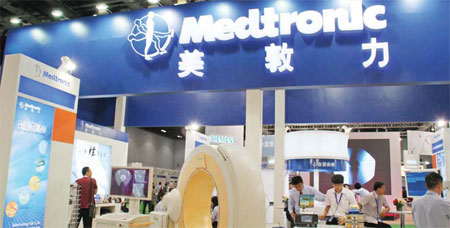Western medical device companies seek expansion in China: huge risks

Multinational health care companies (MNCs) may be salivating at the opportunities in China:
1) By 2016 China is expected to be the second-largest drug market, forecast to reach nearly $165 billion that year
2) During the next several years the Chinese drug market is supposed to grow at a rate of 15% to 18% a year compared to little or no gains for the Western countries
3) Growing affluence is permitting many Chinese to pay out of pocket or pay high insurance deductibles to gain access to innovative Western medicine
4) China needs new drugs to treat higher than average incidences of hepatitis B and neck and head cancers. China also has growth potential for drugs to treat arthritis, diabetes, osteoporosis, high blood pressure, high cholesterol, depression HIV/AIDS.
However, all that glitters may not be gold. The chance of a recession as well as internal politics could make it difficult for the multinational pharmaceutical companies to make strong headway into the Chinese market. Nowhere in the world are the pressures greater to expand access to better health care while at the same time controlling costs.
Examples abound
One policy decision eliminated differential pricing on approximately 100 drugs MNCs sold into China. For nearly two decades, these drugs had benefited from special pricing as part of an agreement between the Chinese government and the pharmaceutical industry. Furthermore, a blind bid and tender process reduced prices on some drugs by up to 90%. MNCs watched as domestic Chinese pharmaceutical companies bid prices down in an effort to use volume gains to offset collapsing margins.
Despite the caution flags, large MNCs continue to devote substantial resources to cracking the Chinese market. Both Pfizer and GlaxoSmithKline have made major moves to re-orient sales resources away from developed economies towards China. Eli Lilly and Novartis , among others, have opened new R&D facilities in China, primarily in Shanghai. And given the country’s mammoth diabetes problem, Sanofi is moving deeper into the country. The company’s Lantus insulin product is estimated to have 17% of the Chinese market.
Large pharmaceutical companies hoping to stake a claim in China may be eyeing two of the country’s largest medical research testing companies as a vehicle to gain entry. Both WuXi PharmaTech and ShangPharma have been mentioned as possible takeover targets.
Even insurance company WellPoint has announced its entry with the hopes that it can develop a private healthcare insurance business. And medical device companies like Boston Scientific, Johnson & Johnson and Medtronic are also aggressively expanding into China. For more information about stocks in this space, our real time trading reports help investors identify opportunities before they happen.
Western medical device companies seek expansion in China
Foreign investors are targeting China’s ageing population as Western medical companies dash to fill the nation’s demand for medical devices geared for China’s 181 million senior citizens.
Moving to tap into the potential market for medical devices aimed at treating seniors, US-based medical companies are investing millions into easing the aches and pains of old age.
In September, Medtronic, a Minneapolis-based medical device maker paid $755 million (584 million euros) for Kanghui Holdings Inc, one of China’s top three manufacturers of spinal support and artificial joints.
“The integration of Kanghui provides Medtronic a strong position in China’s rapidly expanding orthopedics segment, as well as a high potential platform for the development of a global value segment in orthopedics,” said Chris O’Connell, executive vice-president and president of Medtronic’s Restorative Therapies Group, in early November.
Largest overseas acquisition
The takeover is the largest overseas acquisition the medical device maker has made as it targets growth in China’s less competitive second and third-tier cities.
With sales of orthopedic devices in China expected to increase to more than $2.7 billion by 2015, the move indicates how important China’s senior market is for Western companies.
Medtronics is just the latest in a string of US-based medical device companies investing to expand in China’s commercial realm.
Last year, Boston Scientific, one of the US’ largest device-making companies, pledged to invest more than $115 million in expanding its commercial presence in China.
In late October, BG Medicine, a US producer of cardiac diagnostic tests, formed a partnership with Kindstar Diagnostics Co Ltd, the largest esoteric diagnostic testing company in China.
The move will grant BG Medicine access to more than 2,000 hospitals throughout China.
The increased focus by Western medical companies on the China market suggests that as China’s economy continues to expand, so does the desire to offer world-class medical treatment.
For foreign investors looking to establish high-acuity medical care centers for seniors, having access to the latest in medical devices and procedures can mean the difference between success or failure.
“Foreign investors that have their strength in senior care expertise know how to design, build and operate senior care facilities,” says Qu Qun, a lawyer with Shanghai Co-Effort Law Firm and editor of China Senior Housing and Care Newsletter.
“One of their biggest strengths compared with the domestic competition is their access to first-class technology used in senior care facilities and in-home care services.”
Qu estimates that the senior housing and care market will be worth 1.8 trillion yuan ($290 billion; 220 billion euros) a year by 2020 and 7.6 trillion by 2050 and that the money spent on devices geared toward assisting the ailing elderly is only beginning to grow.
And as investors begin to renew their efforts to establish businesses in China, the timing for foreign medical device makers expansion could not be better.
“There is no reason they shouldn’t come and invest here,” Qu says.







